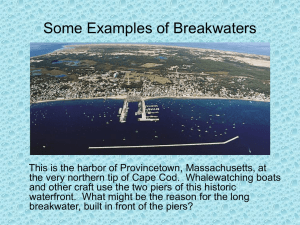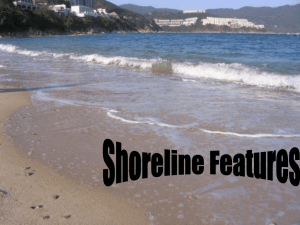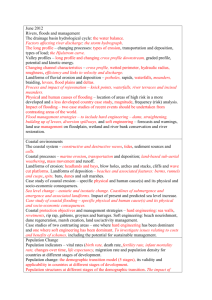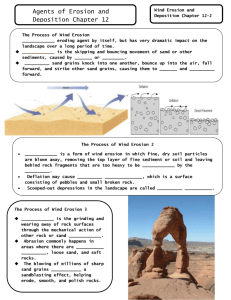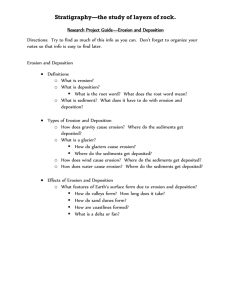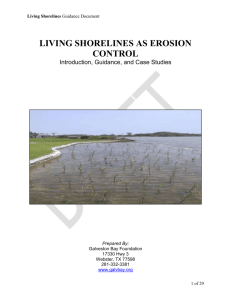Coastal Stabilization Structures
advertisement
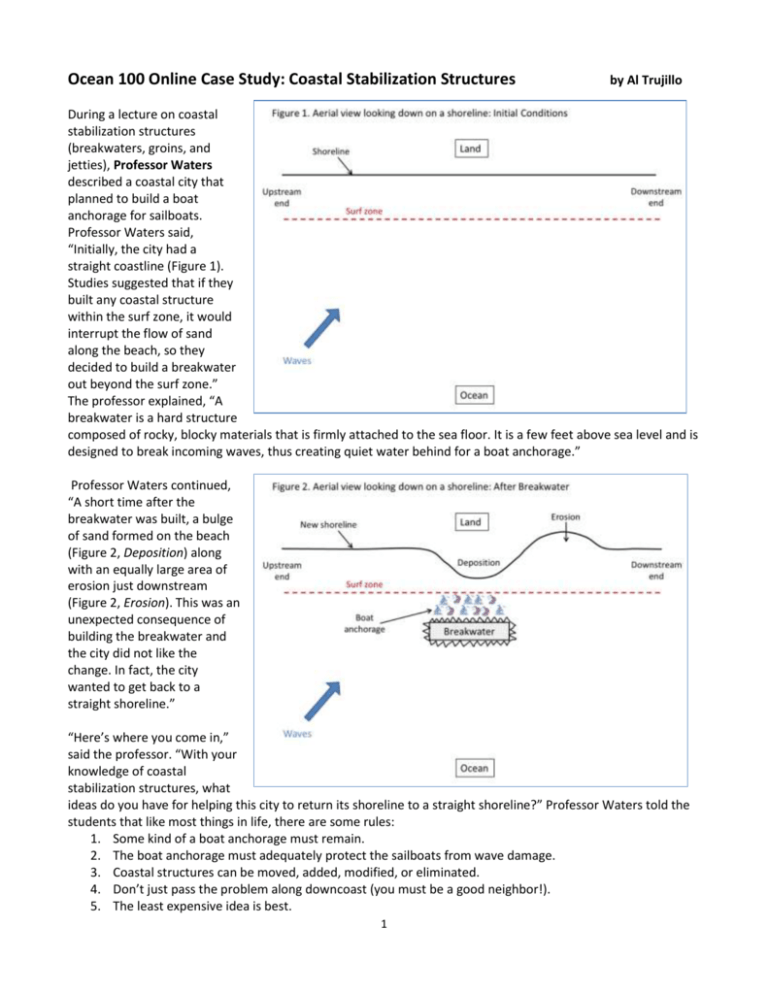
Ocean 100 Online Case Study: Coastal Stabilization Structures by Al Trujillo During a lecture on coastal stabilization structures (breakwaters, groins, and jetties), Professor Waters described a coastal city that planned to build a boat anchorage for sailboats. Professor Waters said, “Initially, the city had a straight coastline (Figure 1). Studies suggested that if they built any coastal structure within the surf zone, it would interrupt the flow of sand along the beach, so they decided to build a breakwater out beyond the surf zone.” The professor explained, “A breakwater is a hard structure composed of rocky, blocky materials that is firmly attached to the sea floor. It is a few feet above sea level and is designed to break incoming waves, thus creating quiet water behind for a boat anchorage.” Professor Waters continued, “A short time after the breakwater was built, a bulge of sand formed on the beach (Figure 2, Deposition) along with an equally large area of erosion just downstream (Figure 2, Erosion). This was an unexpected consequence of building the breakwater and the city did not like the change. In fact, the city wanted to get back to a straight shoreline.” “Here’s where you come in,” said the professor. “With your knowledge of coastal stabilization structures, what ideas do you have for helping this city to return its shoreline to a straight shoreline?” Professor Waters told the students that like most things in life, there are some rules: 1. Some kind of a boat anchorage must remain. 2. The boat anchorage must adequately protect the sailboats from wave damage. 3. Coastal structures can be moved, added, modified, or eliminated. 4. Don’t just pass the problem along downcoast (you must be a good neighbor!). 5. The least expensive idea is best. 1 Amy offered the first idea. She said, “Why don’t they just cut a hole in the middle of the breakwater or break it up into parts? That way, sand could get through to the beach and the erosion would fill in.” Bridgette had a different idea. “Actually, if they just changed the breakwater to make it a floating breakwater, then they could move it to different parts of the coast and they wouldn’t have either the deposition or the erosion,” she said triumphantly. Charles expressed his thoughts. “I don’t think altering the breakwater is a good idea. How about this: If they put a groin to the right of the erosion, it would fill in the erosion with sand because a groin causes upstream deposition,” he explained. “Then, if they put a second groin to the left of the deposition, it would cause downstream erosion and thus eliminate the bulge of sand behind the breakwater. Maybe they could remove the groins when the shoreline was straight again.” Damien shared his perspective about the problem. “Why don’t they just build a boat harbor with jetties to protect the harbor entrance?” he asked. “The best place would be to the left of the deposition. That way, the jetties would cause downstream erosion and thus the deposition would disappear.” Eva offered, “I think they should just move the sand from the deposition to the erosion. This could be done with a suction dredge or even a bulldozer. Maybe to save money, they should make prison inmates move the sand with shovels and buckets.” Then Fred suggested, “Yeah, but they’re not getting rid of the root of the problem, which is the breakwater in the first place. Since we can’t eliminate the breakwater, why not move it further offshore? They’d still keep the anchorage, but it would just be a little further to get to the sailboats.” Gracie, after hearing all the other ideas, came up with, “I think the breakwater could be designed differently to still protect the boats, but have a minimum impact on the shoreline. Maybe redesign it into the shape of a wedge or a circle. That way, the waves could go around it and keep moving the sand down the beach, thus taking care of both the deposition and the erosion.” Critically analyze each student’s idea, including its potential drawbacks. Listed below are the students in the story. Considering the rules established for the exercise, rank each student’s idea from most feasible to least feasible for helping the city get its shoreline back to a straight shoreline. Give a different score to each character. Be prepared to explain your choices. Most feasible idea <― 1 2 3 4 5 6 7 ―> Least feasible idea _____ Amy _____ Damien _____ Bridgette _____ Eva _____ Charles _____ Fred _____ Gracie Diving deeper: Other than combinations of the student’s ideas, what other ideas do you have for helping the city return its shoreline to a straight shoreline? 2
